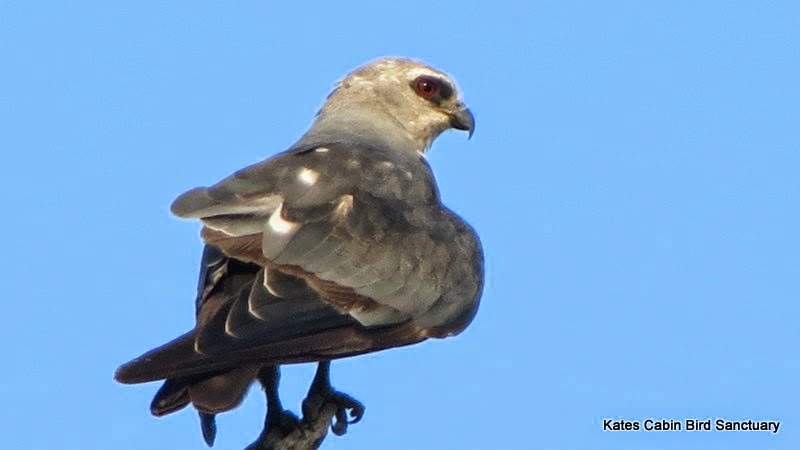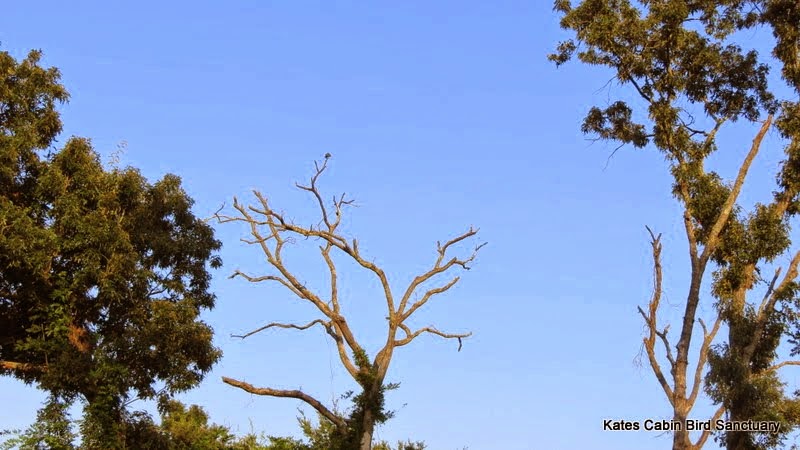
Hi Everybody!!
The Kites spend the summer here on the creek. They whistle in the trees. I whistle at them and they answer. This one likes to be photographed and show off his flying speeds in the air. I encourage you to photograph your birds to get them acquainted with cameras. Once they know it will not hurt them, they stop flying off. Too many men and young boys still point guns at birds and shoot them. It falls on the rest of us bird lovers to stop this deadly sport behavior by raising awareness of the vanishing bird populations. So shoot your birds with cameras and make a new friend! Enjoy!

https://en.wikipedia.org/wiki/Mississippi_kite
Mississippi kite
From Wikipedia, the free encyclopedia
| Mississippi kite | |
|---|---|
 | |
| In Oklahoma, USA | |
| Conservation status | |
| Scientific classification | |
| Kingdom: | Animalia |
| Phylum: | Chordata |
| Subclass: | Aves |
| Order: | Falconiformes (or Accipitriformes, q.v.) |
| Family: | Accipitridae |
| Genus: | Ictinia |
| Species: | I. mississippiensis |
The Mississippi kite (Ictinia mississippiensis) is a small bird of prey in the family Accipitridae. It is 12 to 15 inches (30–37 cm) beak to tail and has awingspan averaging 3 feet (91 cm). Weight is from 214 to 388 grams (7.6-13.7 oz).[2] Adults are gray with darker gray on their tail feathers and outer wings and lighter gray on their heads and inner wings. Males and females look alike, but the males are slightly paler on the head and neck. Young kites have banded tails and streaked bodies.[3] Mississippi kites have narrow, pointed wings and are graceful in flight, often appearing to float in the air. It is not uncommon to see several circling in the same area. Their diet consists mostly of insects which they capture in flight. They eat cicada,grasshoppers, and other crop-damaging insects, making them economically important. They have also been known to eat small vertebrates, including amphibians, reptiles, mammals, and occasionally birds. Their call is a high-pitched squeak, sounding similar to that of a squeaky dog toy.
Mississippi kites breed across the central and southern United States. Breeding territory has expanded in recent years and Mississippi kites have been regularly recorded in the southern New England states and a pair has successfully raised young as far north as Newmarket, New Hampshire.[4] They migrate to southern subtropical South America in the winter. Mississippi kites usually lay two white eggs (rarely one or three) in twig nests that rest in a variety of deciduous trees. In the past 75 years, they have undergone changes in nesting habitat from use of forest and savanna to include shelterbeltsand are now very common nesters in urban area that are highly populated in the western south-central states.
Mississippi kites nest in colonies and both parents (paired up before arriving at the nesting site) incubate the eggs and care for the young.[5] They have one clutch a year which takes 30 to 32 days to hatch. The young birds leave the nest another 30 to 35 days after hatching. Only about half of kites successfully raise their young. Clutches fall victim to storms and predators such as raccoons and great horned owls. Because of the reduced amount of predators in urban areas, Mississippi kites produce more offspring in urban areas than rural areas. They have an average lifespan of 8 years.[5]
While the Mississippi kite is not an endangered species,[1] it is protected under the Migratory Bird Treaty Act of 1918,[6] which protects the birds, their eggs, and their nests (occupied or empty) from being moved or tampered with without the proper permits. This can make the bird somewhat of a nuisance when it chooses to roost in populated urban spots such as golf courses or schools. The birds protect their nests by diving at perceived threats, including humans. Staying at least 50 yards from nests is the best way to avoid conflict with the birds.[citation needed] If unavoidable, wearing a hat or waving hands in the air should prevent contact from being made but will not prevent the diving behavior.

He is in very top of dead tree for perspective

https://plus.google.com/u/0/photos/117645114459863049265/albums/6041864937506947089
Hummer Update:
For the first time in my life, I had 2 hummers winter over here at Kates Cabin. (I have photo documentation in my G+Albums).
Anyway, they had one baby (in pics below).
Elvis came in early August and the others began arriving around the 12th. They arrive at the same time every year and return to their favorite feeders from the year before. This year I have added a new feeding area with birdshower and bath! So far, the numbers are way down. I have about 20 birds here today. They are squeaking with delight and zipping through the air. I have all the August photos yet to share, so you will see plenty of the little hummers! I look forward to everyday!
JULY 29

https://plus.google.com/u/0/photos/117645114459863049265/albums/6042023091171859617/6042026318016971186?pid=6042026318016971186&oid=117645114459863049265

https://plus.google.com/u/0/photos/117645114459863049265/albums/6042023091171859617/6042025430611940962?pid=6042025430611940962&oid=117645114459863049265

https://plus.google.com/u/0/photos/117645114459863049265/albums/6042032074772556081/6042032928986335442?pid=6042032928986335442&oid=117645114459863049265

https://plus.google.com/u/0/photos/117645114459863049265/albums/6042032074772556081/6042032943634162994?pid=6042032943634162994&oid=117645114459863049265
...this is brendasue signing off from Rainbow Creek. See you next time! I hope you encounter flying things! Bee with me!

https://plus.google.com/u/0/photos/117645114459863049265/albums/6041981664839395457/6041982111963441842?pid=6041982111963441842&oid=117645114459863049265
O+O


No comments:
Post a Comment